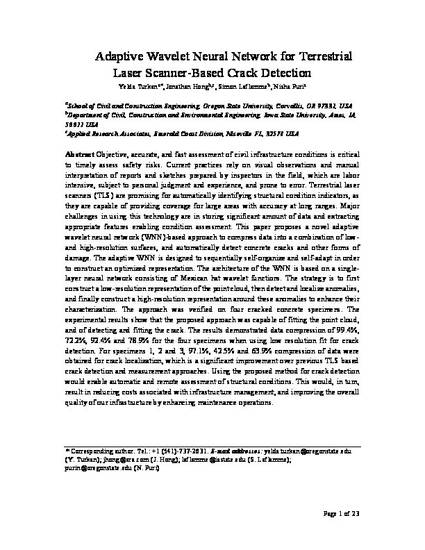
Objective, accurate, and fast assessment of civil infrastructure conditions is critical to timely assess safety risks. Current practices rely on visual observations and manual interpretation of reports and sketches prepared by inspectors in the field, which are labor intensive, subject to personal judgment and experience, and prone to error. Terrestrial laser scanners (TLS) are promising for automatically identifying structural condition indicators, as they are capable of providing coverage for large areas with accuracy at long ranges. Major challenges in using this technology are in storing significant amount of data and extracting appropriate features enabling condition assessment. This paper proposes a novel adaptive wavelet neural network (WNN)-based approach to compress data into a combination of low- and high-resolution surfaces, and automatically detect concrete cracks and other forms of damage. The adaptive WNN is designed to sequentially self-organize and self-adapt in order to construct an optimized representation. The architecture of the WNN is based on a single-layer neural network consisting of Mexican hat wavelet functions. The strategy is to first construct a low-resolution representation of the point cloud, then detect and localize anomalies, and finally construct a high-resolution representation around these anomalies to enhance their characterization. The approach was verified on four cracked concrete specimens. The experimental results show that the proposed approach was capable of fitting the point cloud, and of detecting and fitting the crack. The results demonstrated data compression of 99.4%, 72.2%, 92.4% and 78.9% for the four specimens when using low resolution fit for crack detection. For specimens 1, 2 and 3, 97.1%, 42.5% and 63.9% compression of data were obtained for crack localization, which is a significant improvement over previous TLS based crack detection and measurement approaches. Using the proposed method for crack detection would enable automatic and remote assessment of structural conditions. This would, in turn, result in reducing costs associated with infrastructure management, and improving the overall quality of our infrastructure by enhancing maintenance operations.
Available at: http://works.bepress.com/simon_laflamme/98/

This is a manuscript of an article published as Turkan, Yelda, Jonathan Hong, Simon Laflamme, and Nisha Puri. "Adaptive wavelet neural network for terrestrial laser scanner-based crack detection." Automation in Construction 94 (2018): 191-202. doi: 10.1016/j.autcon.2018.06.017. Posted with permission.